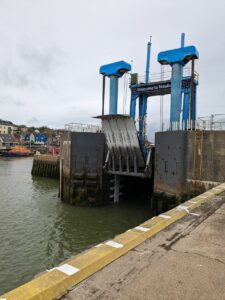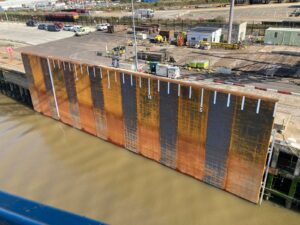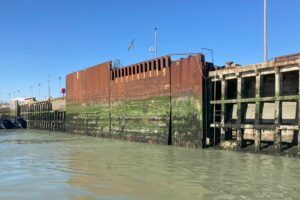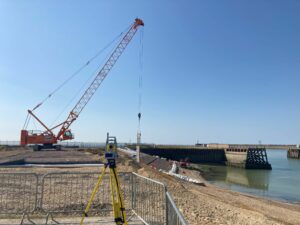
The Port of Newhaven is a busy commercial harbour on the mouth of the River Ouse, East Sussex, providing regular cross-channel connections for freight and passengers.
Beckett Rankine has a longstanding relationship with Newhaven Port Authority, providing design and management of key assets for decades.
As a result, we have had the opportunity to demonstrate a cross-section of our maritime engineering expertise through our work on quay walls, flood defences, jetties and linkspans.
We identified and managed repairs needed to extend this asset’s life, including replacing the bearings and steel beams that support the deck.
As Newhaven is a working port, it was vital that ferry services continued throughout the works. We produced designs that allowed for this and worked with the contractor to optimise the construction methodology.
In order to minimise disruption, we carried out trial runs of the construction process in between ferry services, at the beginning of the programme. The identified solution was to lift the linkspan on to temporary bearings so that work could progress on the permanent ones. Replacement of steelwork was timed and co-ordinated such that no ferry sailings were affected or cancelled. We monitored the bridge carefully throughout to check for movement and ensure the safety of all.

For safety reasons, during bad weather vehicle and passenger ferries have to turn 180° in a relatively narrow channel after loading and unloading.
A unique concept was designed and implemented by Beckett Rankine in 1991 – a large ‘turning plate’ was installed on the quay wall for the ferries to use as a buffer, allowing them to make contact with the structure and aid turning without damaging the existing quay wall or vessel. The structure consists of heavy steelwork that bears onto rubber fenders.
The original structure had reached the end of its design life, and so we installed a new, larger turning plate that will allow modular replacement going forward. The new turning plate is designed to accommodate larger vessel sizes and accounts for rising sea levels and changing tides.
We contracted Mackley Engineering to produce pre-fabricated modular units. These were then assembled and lowered into place by crane, minimising the impact on port operations during the works.


The ‘Cut Out’ is a beach area at the mouth of the River Ouse that has experienced severe erosion in recent years, destabilising the beach slope and existing flood defences.
We are managing and designing works to install a new revetment, which will restore the beach to its original profile and provide protection from future erosion. We are managing contractors on site, who are re-profiling the beach, installing ground anchors, and laying flexible concrete mattress.

Further upriver from the Port’s ferry berth, local fishermen use several jetties as fishing stages to moor their vessels. However, some of these structures have fallen into a state of disrepair.
Thanks to UK Government funding secured by Lewes District Council, Newhaven Port has commissioned a new, replacement fishing stage to support the local fishing industry and community.
Beckett Rankine produced the scheme design and managed the planning process, followed by a detailed design package to optimise and value engineer the most cost-effective solution for the site conditions. We have been further appointed to oversee management of the construction and site supervision.
Two of the existing fishing stages will be demolished to replace them with one larger, 50m long structure. It will have access to a mooring pontoon, designed to move with the river’s ~7m tidal range.
The work will involve stabilising the existing riverbank and dredging in front of the structure to accommodate the moored vessels, and real-time monitoring of ground movement during construction.
Despite its relatively small size, the project encompasses a wide variety of construction activities like piling, earthworks, structural steelwork and dredging.
Beckett Rankine’s extensive experience in optimising designs has been evident at every step. For example, the pontoon design has been influenced by similar pontoons and piers we’ve completed on the River Thames, which has a comparable tidal range to the Ouse, and the ground movement monitoring uses a system and methodology we refined in the Freetown Port Expansion, Sierra Leone.
The contract for works was awarded to Herbosch-Kiere in May 2025. They were successful in the tender process due to their capability to carry out the range of construction activities in-house using marine-based plant, providing a holistic approach that is less disruptive to the adjacent public area, more cost-effective and more responsive to changes on-site.
The new fishing stage is expected to be completed in early 2026.